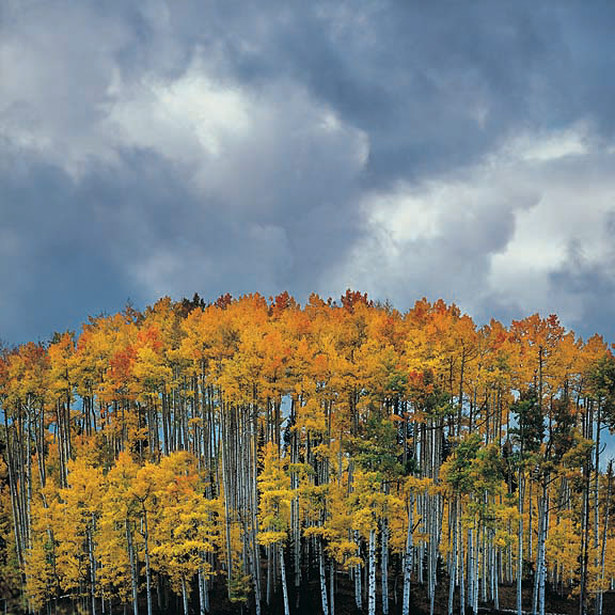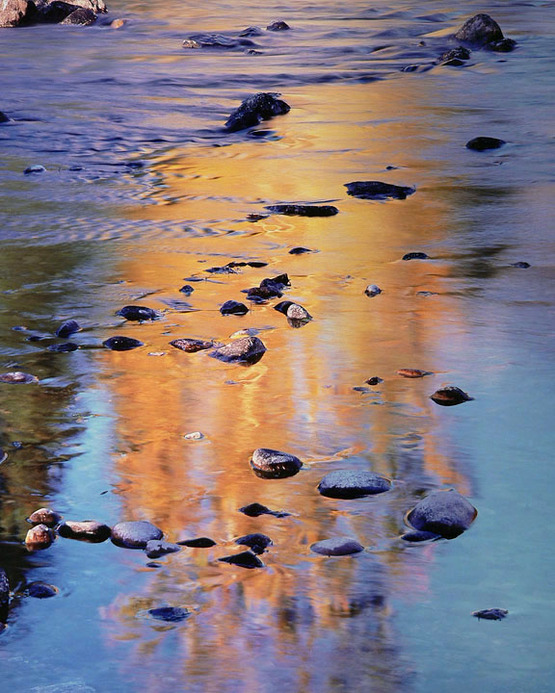Christopher Burkett
The Creekwalker Interview 1998
As one of the world's premier color photographers, Christopher Burkett
combines a master's eye for process and detail with a profound,
mystical appreciation for the wonders of nature. Having once lived as a
monk in a Christian order, Burkett left the brotherhood in 1979 to
pursue photography. After marrying his wife, Ruth, Burkett worked in
the printing trade where he began to learn the art of color separation.
An acknowledged expert in the art of crafting Cibachrome (Ilfochrome)
prints, Burkett's work has received international acclaim.
websites: www.christopherburkett.com
combines a master's eye for process and detail with a profound,
mystical appreciation for the wonders of nature. Having once lived as a
monk in a Christian order, Burkett left the brotherhood in 1979 to
pursue photography. After marrying his wife, Ruth, Burkett worked in
the printing trade where he began to learn the art of color separation.
An acknowledged expert in the art of crafting Cibachrome (Ilfochrome)
prints, Burkett's work has received international acclaim.
websites: www.christopherburkett.com
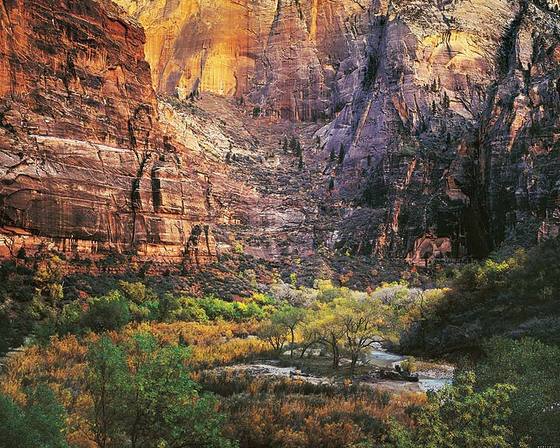
Twilight, Virgin River and Zion Canyon, Utah
Creekwalker: At one time you were a brother in a Christian order. How do the disciplines you practiced then affect your work as a photographer now?
Burkett: All aspects of my life, certainly including my photography, have been profoundly affected by my life in a religious order. To do well in any field requires inspiration, dedication and a technical proficiency and we all do our best work through the help and grace of God.
Burkett: All aspects of my life, certainly including my photography, have been profoundly affected by my life in a religious order. To do well in any field requires inspiration, dedication and a technical proficiency and we all do our best work through the help and grace of God.
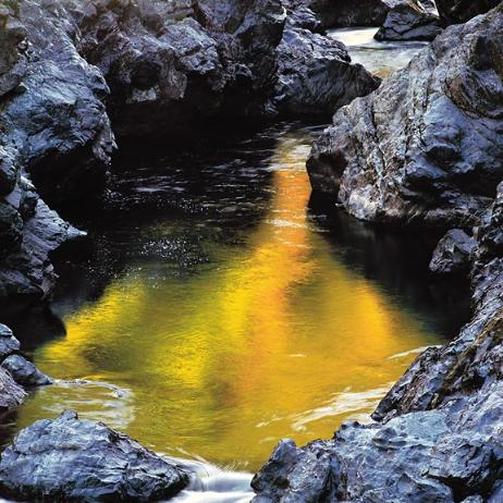
Golden River Pool, Oregon
Creekwalker: How long does it generally take to create one of your prints from an 8x10 transparency?
Burkett: When working with a new image, it usually takes from 8 to 24
hours of work to produce the first good print. Sometimes longer, very
rarely shorter. Much of the time involves looking at the image and
deciding how to make it as close to perfect as I can. I don't stop until
I can't improve it any more (the next time I reprint the image, I always
try to improve it even more).
There's always the feeling that there is still more that could be done
to make the print even better. It is no exaggeration to say that the first
90% of the work takes 10% of the time, but fine-tuning the print
allows luminosity and life to begin to shine forth in the work.
Creekwalker: What kind of equipment do you use? (camera, enlarger, film)?
Burkett: Most of my work is photographed with an 8x10 view camera, an older Calumet C-1 metal flat bed camera. I also use a Hasselblad for some 2 1/4 work (there are times when it is just not possible to use an 8x10, especially if the wind is blowing significantly). I used to use Fujichrome 100 film, but it has been discontinued in the 8x10 size, so I use primarily Velvia film at this time. I make contrast masks for every image (and specialty masks, when required). Masking is the key to good color printing as it gives a person extensive tone reproduction controls. I print onto Cibachrome CPS.1K (Ilfochrome Classic Deluxe), using a larger horizontal enlarger, a Devere 1010ET machine with a 5,000 watt closed-loop color head and a Kreonite 42" roller transport machine to process the prints.
I have 12 different view camera lenses: 120mm, 150mm, 210mm, 240mm, 300mm, 360mm, 450mm, 600mm, 30", 35", 42", and 48". Most of my work (about 80%) is done with either the 600mm or the 30" lenses. For the Hasselblad, I use the 50mm, 80mm, 100mm, 120mm, 180mm and the 250mm Superachromat, with the 1.4x and 2x newer teleconverter. For enlarging, I use the very specialized Apo-EL-Nikkor lenses, although I am still trying to find a quite rare 480mm lens for use with 8x10.
While I now have a large range of lenses, it is important to realize that this is a very recent development. Most of my work has been done with very few lenses and I started out (like just about everyone) with a small amount of equipment. In 1987, when I first began using an 8x10 camera, I had just two lenses (a 450mm and 600mm). I do believe in getting the best lenses you can afford, even if it's just one lens.
Burkett: When working with a new image, it usually takes from 8 to 24
hours of work to produce the first good print. Sometimes longer, very
rarely shorter. Much of the time involves looking at the image and
deciding how to make it as close to perfect as I can. I don't stop until
I can't improve it any more (the next time I reprint the image, I always
try to improve it even more).
There's always the feeling that there is still more that could be done
to make the print even better. It is no exaggeration to say that the first
90% of the work takes 10% of the time, but fine-tuning the print
allows luminosity and life to begin to shine forth in the work.
Creekwalker: What kind of equipment do you use? (camera, enlarger, film)?
Burkett: Most of my work is photographed with an 8x10 view camera, an older Calumet C-1 metal flat bed camera. I also use a Hasselblad for some 2 1/4 work (there are times when it is just not possible to use an 8x10, especially if the wind is blowing significantly). I used to use Fujichrome 100 film, but it has been discontinued in the 8x10 size, so I use primarily Velvia film at this time. I make contrast masks for every image (and specialty masks, when required). Masking is the key to good color printing as it gives a person extensive tone reproduction controls. I print onto Cibachrome CPS.1K (Ilfochrome Classic Deluxe), using a larger horizontal enlarger, a Devere 1010ET machine with a 5,000 watt closed-loop color head and a Kreonite 42" roller transport machine to process the prints.
I have 12 different view camera lenses: 120mm, 150mm, 210mm, 240mm, 300mm, 360mm, 450mm, 600mm, 30", 35", 42", and 48". Most of my work (about 80%) is done with either the 600mm or the 30" lenses. For the Hasselblad, I use the 50mm, 80mm, 100mm, 120mm, 180mm and the 250mm Superachromat, with the 1.4x and 2x newer teleconverter. For enlarging, I use the very specialized Apo-EL-Nikkor lenses, although I am still trying to find a quite rare 480mm lens for use with 8x10.
While I now have a large range of lenses, it is important to realize that this is a very recent development. Most of my work has been done with very few lenses and I started out (like just about everyone) with a small amount of equipment. In 1987, when I first began using an 8x10 camera, I had just two lenses (a 450mm and 600mm). I do believe in getting the best lenses you can afford, even if it's just one lens.
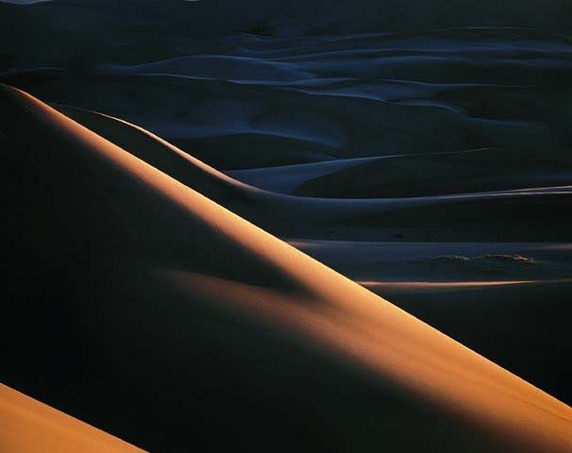
Sunset, Great Sand Dunes, Colorado
Creekwalker: Are there photographers whose work you admire? Collect?
Burkett: There are many photographers and painters whose work I admire. Usually it is work which is quite different than mine, although often in black and white. I love black and white work (I started out photographing in black and white for about five years). I think that I've learned more about the creative use of color from painters than from photographers. I have a hard time listing specific artists and any list would be incomplete and probably not too useful. There's a lot of wonderful work done by many. I do have some prints by other photographers, such as Ruth Bernhard, Takako Wastman, John Sexton, Oliver Gagliani, Brett Weston, Dan Burkholder, and others.
Burkett: There are many photographers and painters whose work I admire. Usually it is work which is quite different than mine, although often in black and white. I love black and white work (I started out photographing in black and white for about five years). I think that I've learned more about the creative use of color from painters than from photographers. I have a hard time listing specific artists and any list would be incomplete and probably not too useful. There's a lot of wonderful work done by many. I do have some prints by other photographers, such as Ruth Bernhard, Takako Wastman, John Sexton, Oliver Gagliani, Brett Weston, Dan Burkholder, and others.
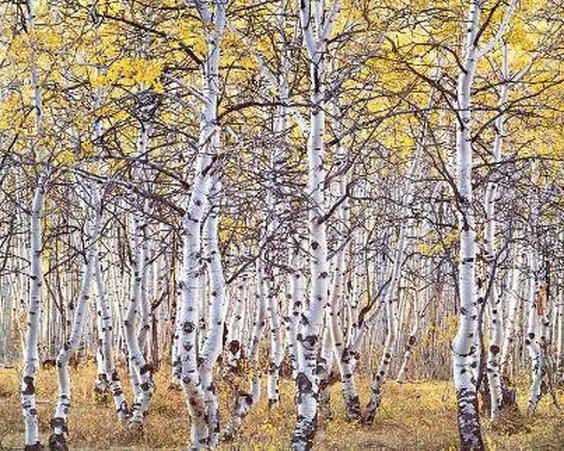
Black Mountain Aspen Forest, Utah
Creekwalker: How do you go about selecting the geographical areas you photograph?
Burkett: There's a combination of experience, observation and intuition. I've been to many places around the country and have a rough idea of what's there. I see articles or hear from others about areas that may have potential, and then there's sometimes a hunch that something worthwhile might be "just over the mountain ridge".
Creekwalker: What parts of the country would you like to
photograph that you haven't, so far.
Burkett: I've been to every state, but this country is immense and there are always vast areas to discover. Most of what I photograph is close at hand and not the "grand view", so I literally never know what I'm going to discover as I travel about. I usually try to go to someplace new every year in addition to going back to areas which have been productive in the past.
Burkett: There's a combination of experience, observation and intuition. I've been to many places around the country and have a rough idea of what's there. I see articles or hear from others about areas that may have potential, and then there's sometimes a hunch that something worthwhile might be "just over the mountain ridge".
Creekwalker: What parts of the country would you like to
photograph that you haven't, so far.
Burkett: I've been to every state, but this country is immense and there are always vast areas to discover. Most of what I photograph is close at hand and not the "grand view", so I literally never know what I'm going to discover as I travel about. I usually try to go to someplace new every year in addition to going back to areas which have been productive in the past.
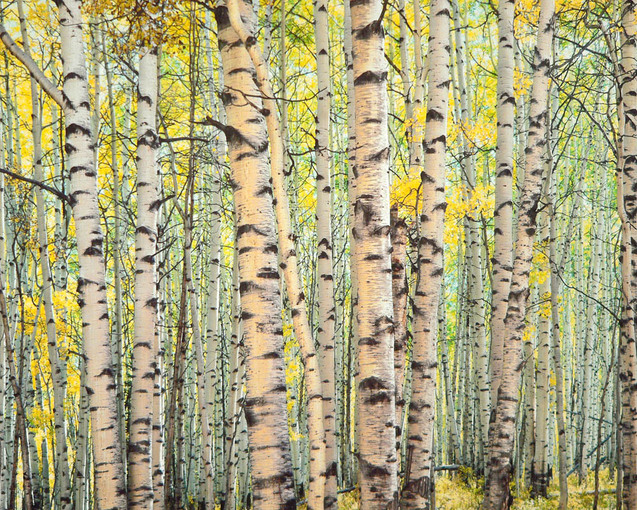
Trout Creek Aspen Forest, Colorado
Creekwalker: When photographing, do you camp out or stay elsewhere and drive to your locales?
Burkett: Normally, I camp out close by wherever I'm photographing. We have a conversion van which makes it very convenient, although in the past we used a small tent. East of the Mississippi, it becomes increasingly difficult to find places to camp.
Burkett: Normally, I camp out close by wherever I'm photographing. We have a conversion van which makes it very convenient, although in the past we used a small tent. East of the Mississippi, it becomes increasingly difficult to find places to camp.
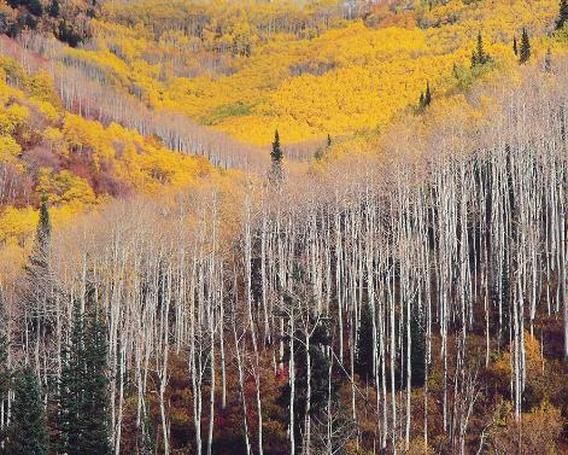
Fairview Mountain Aspens, Utah
Creekwalker: Is there a growing market for your work overseas, yet?
Burkett: Nothing at all overseas, although I sell some work through the galleries which represent me to customers overseas.
Creekwalker: Describe a typical days' work.
Burkett: While there is no "typical day", all of them are long. I'm an early my favorite time of the day to work and most of my life is spent in the darkroom. My studio and darkroom are in a separate building right near our house, which is very convenient. Nearly every moment of every day is spent with something to do with photography (except Sunday, of course). There's a certain amount of business activity and paperwork but I try to stay focused on the creative work. There's still never enough time to get everything done and I seem to always have more projects and unfinished work accumulating. Life is very full!
Burkett: Nothing at all overseas, although I sell some work through the galleries which represent me to customers overseas.
Creekwalker: Describe a typical days' work.
Burkett: While there is no "typical day", all of them are long. I'm an early my favorite time of the day to work and most of my life is spent in the darkroom. My studio and darkroom are in a separate building right near our house, which is very convenient. Nearly every moment of every day is spent with something to do with photography (except Sunday, of course). There's a certain amount of business activity and paperwork but I try to stay focused on the creative work. There's still never enough time to get everything done and I seem to always have more projects and unfinished work accumulating. Life is very full!
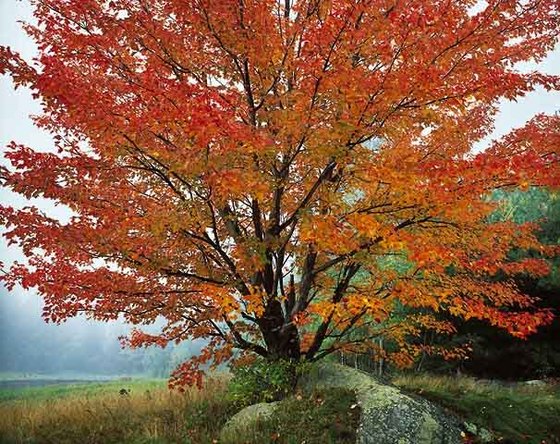
Wild Red Maple And Fog, New Hampshire
Creekwalker: How many prints do you normally make from
each image?
Burkett: Each print I make of an image is numbered sequentially,
but there is no fixed upper limit. I raise the price of an image as
more are sold, which limits the quantities, protects the previous
buyer, and yet leaves the image available. Since I am the only
one who will ever print my work, the quantities are necessarily
limited by my lifetime.
Creekwalker: In your travels, do you have a favorite region such as New England or the Grand Canyon that you'd like to return to?
Burkett: There are many favorite spots, including most of Utah, western Colorado and all of the Appalachia mountains.
each image?
Burkett: Each print I make of an image is numbered sequentially,
but there is no fixed upper limit. I raise the price of an image as
more are sold, which limits the quantities, protects the previous
buyer, and yet leaves the image available. Since I am the only
one who will ever print my work, the quantities are necessarily
limited by my lifetime.
Creekwalker: In your travels, do you have a favorite region such as New England or the Grand Canyon that you'd like to return to?
Burkett: There are many favorite spots, including most of Utah, western Colorado and all of the Appalachia mountains.
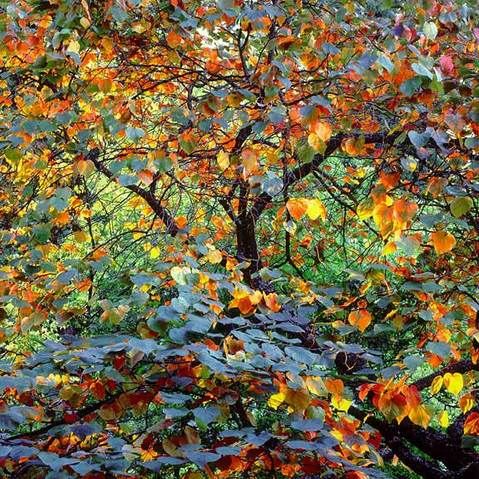
Autumn Circus, Oregon
Creekwalker: How does your relationship with God affect the practice of your craft?
Burkett: Our relationship with God affects every aspect of our life and determines the course and tone of everything we see, think, feel and experience. Without God, nothing is possible and life has no meaning. From this viewpoint, each person's relationship with God profoundly affects all aspects of their lives and is probably most felt in the areas of inspiration and dedication.
Burkett: Our relationship with God affects every aspect of our life and determines the course and tone of everything we see, think, feel and experience. Without God, nothing is possible and life has no meaning. From this viewpoint, each person's relationship with God profoundly affects all aspects of their lives and is probably most felt in the areas of inspiration and dedication.
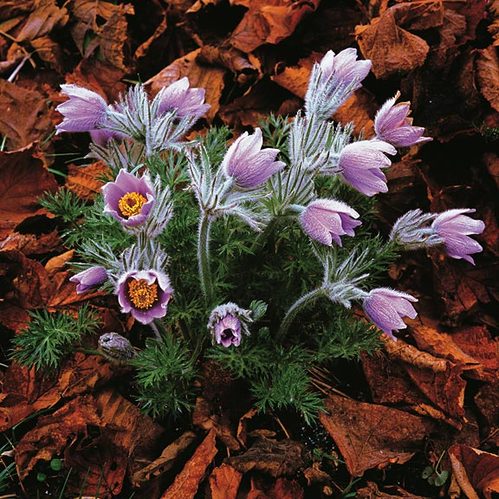
Pascal Lily, Oregon
Creekwalker: How does the impact of Greek Orthodoxy, specifically, play into your life and work?
Burkett: Actually, we're American Orthodox (same theology/religion, just not ethnically Greek). Orthodoxy is a very full and rich expression of Christianity and requires quite active participation and personal responsibility. This means certain prayers are said during various times of the day and other activities, although the real purpose of Orthodoxy is to bring each person closer to God. Much is required of each individual and nothing should be taken for granted. As the Scriptures instruct, prayer, fasting and acts of mercy are the basis of our lives. One of the appealing aspects of Orthodoxy is its emphasis on the direct experiencing of God, including the value of art in this process.
Burkett: Actually, we're American Orthodox (same theology/religion, just not ethnically Greek). Orthodoxy is a very full and rich expression of Christianity and requires quite active participation and personal responsibility. This means certain prayers are said during various times of the day and other activities, although the real purpose of Orthodoxy is to bring each person closer to God. Much is required of each individual and nothing should be taken for granted. As the Scriptures instruct, prayer, fasting and acts of mercy are the basis of our lives. One of the appealing aspects of Orthodoxy is its emphasis on the direct experiencing of God, including the value of art in this process.
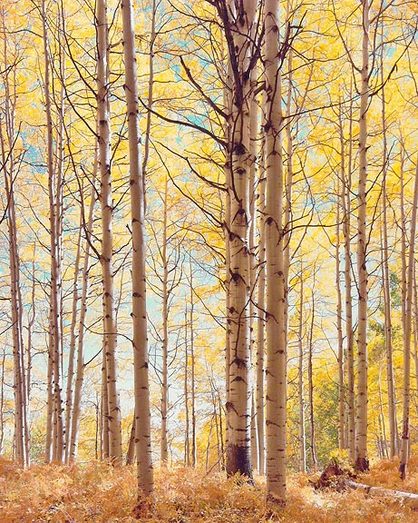
Translucent Forest, Colorado
Creekwalker: Is there anything you'd like to add about how your wife assists you in your work?
Burkett: Ruth has always been very supportive of my work and has been behind me throughout the many years I've been working at this. She goes with me on most of our photo trips and does nearly all of the driving and helps lug (heavy!) equipment all over the place. She also helps in the office and is excellent on the phone with the galleries and other contacts. As I'm working on a new print I will often show it to her when it's almost done and I listen to her comments. Most importantly, she prays for me often, which is the biggest help of all.
Burkett: Ruth has always been very supportive of my work and has been behind me throughout the many years I've been working at this. She goes with me on most of our photo trips and does nearly all of the driving and helps lug (heavy!) equipment all over the place. She also helps in the office and is excellent on the phone with the galleries and other contacts. As I'm working on a new print I will often show it to her when it's almost done and I listen to her comments. Most importantly, she prays for me often, which is the biggest help of all.
© Copyright 1998 Tawnybark/Creekwalker. Photography © Christopher Burkett. All rights reserved.
